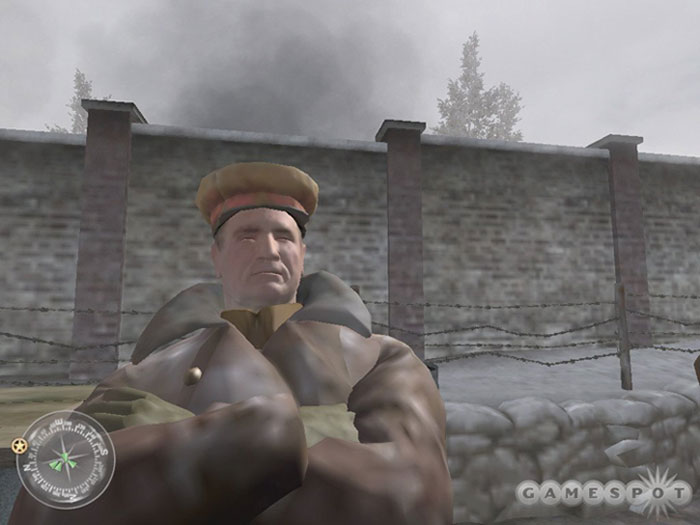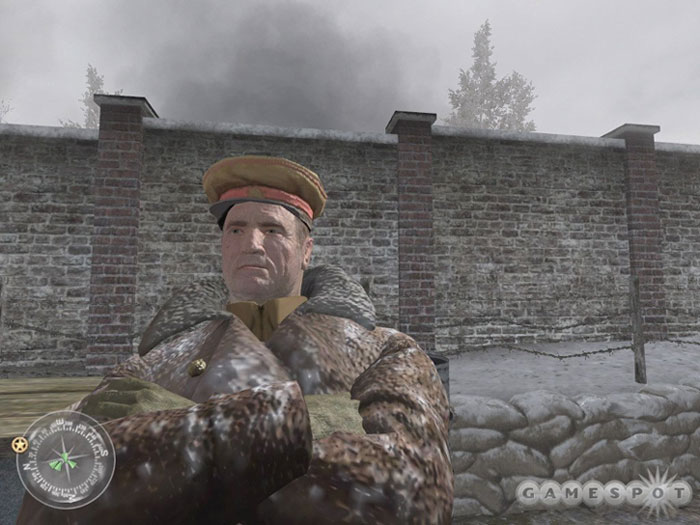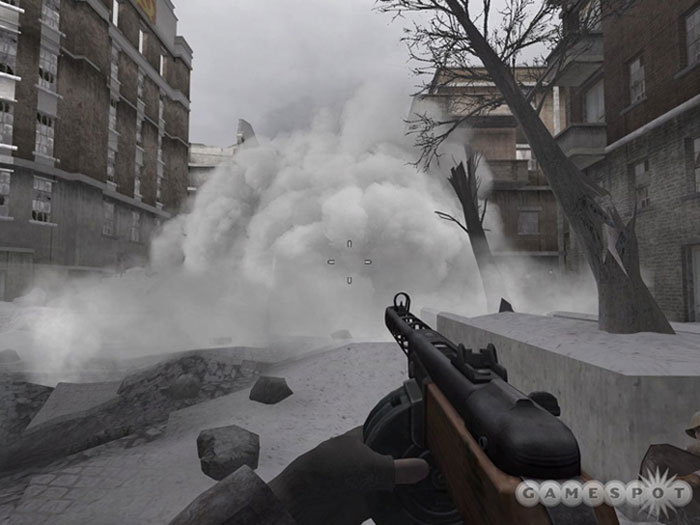Call of Duty 2 Hardware Performance Guide
Does Call of Duty 2 run sluggishly on your computer? Read on to learn how to make it run silky smooth.
In its unrelenting quest for dominance in the overly crowded WWII shooter genre, Call of Duty 2 introduces a new graphics engine based on DirectX 9. The new engine features lighting and smoke effects that will wow you with their fantastic looks, and make you whimper at their ability to make your gaming rig feel like an antiquated pile of junk.
We tested out all the in-game settings, scores of video cards, numerous processors, and multiple memory settings to find out where the frame rate pileup occurs. The answer, it turned out, was simple. The game demands a state-of-the-art video card. Unfortunately, even the newest generation of graphics processors don't offer enough performance to satisfy this game.
Call of Duty 2 comes with built-in benchmarking software, but we chose to manually run a FRAPS test on the beginning of one of the later Russia levels. Our test focused on the snow effects, combined with smoke grenades and computer combatants, to get a consistent score.
Guide Sections
Call of Duty 2 will demolish any system put in its path. Short of scaling back graphical detail, you cannot mitigate frame rate loss even if you have the best hardware. We divided our feature into four sections to help you determine what you need to improve your gaming experience.
Game Settings
You're going to have to give up some eye candy if you want to run Call of Duty 2 with smooth-as-butter frame rates. While there are very few graphic settings that will greatly change how the game looks and feels, we have documented which ones affect gameplay the most.
Graphics
To say that Call of Duty 2 doesn't play nice with graphics cards is an understatement. Anything older than a Radeon X700 Pro will likely render the game basically unplayable. We'll show you the differences between the video cards by throwing 14 different cards at the game.
CPU
Holding everything else constant, we ran our Athlon 64 FX-57 at 2.8GHz and then throttled it all the way down to 1.6GHz to see how CPU speed affected frame rates.
Memory
We threw the game up against various memory sizes starting at 256MB all the way through to 2GB to see what effect RAM has on the game.
Settings
Changing the in-game graphical settings is a surefire way to improve performance without having to run out and buy new hardware. We tested each setting one by one to determine which settings you could enable to get the highest possible frame rate while still maintaining decent image quality. As with most games, lowering the resolution will improve performance considerably. Aside from the usual anisotropic filtering and antialiasing frame rate killers, the only setting that seemed to have any meaningful effect on frame rate was shadows.
Call of Duty gives you the option of running the game under the DirectX 7 path, but playing under DirectX 7 is almost like playing a different game--you might as well play the first Call of Duty. All the details present in DirectX 9 completely disappear when the game runs under DirectX 7. Choosing this will kill many of the graphical effects that help make Call of Duty 2 one of the most aesthetically pleasing games to date. With that little disclaimer out of the way, running under DirectX 7 will do miracles for your computer's performance. Expect to see your frame rate double, if not triple.
If you've been looking across the Web for ways to improve the game's performance, you might have come across two commands in particular (r_applypicmips and r_multigpu) that people have had some success using. We contacted some of the developers at Infinity Ward to see if these commands actually help, and this is what they had to say with respect to the two commands.
r_applypicmips: "This basically gets the drivers to reload the textures. It doesn't make the game faster on our machines, but it is theoretically possible. Nvidia released a new driver that they said makes COD2 faster--so maybe this was related."
r_multigpu: "When used with single GPU cards, this will increase the FPS number. But it will introduce the "mouse lag" that many D3D games have. Basically, the driver will buffer up several frames to give an artificially high FPS count, at the expense of responsiveness (because what is drawn to the screen may be three frames behind "now")."
AMD Athlon 64 FX-57 CPU, Asus A8N SLI Deluxe, 1GB (512MB x 2) Corsair XMS Memory, 250GB Maxtor Maxline III SATA Hard Disk Drive, Windows XP Professional.
Graphics Card: GeForce 7800 GTX, GeForce 6800 GS, Radeon X1800XT, Radeon X1600, Radeon X300SE.
Graphics Drivers: Nvidia ForceWare 81.85, ATI Catalyst 5.10, beta.
Video Cards
Aside from providing lots of entertainment, games like Call of Duty 2 and F.E.A.R. act as demarcation points for upgrading your system. You will without a doubt want to put your video card out to pasture the moment you turn on Call of Duty 2. If you don't have a current-generation card or a high-end card from the previous generation, you're going to miss a lot of what the game has to offer.
A better video card will get you better performance but, even cards like the GeForce 7800 GTX falter when it comes to running Call of Duty 2 with all the settings maxed out. Most users will have to relax a few image-quality settings in order to get the game to run smoothly.
If you're not in the mood to spend an extra few hundred dollars on a new video card, you can easily boost frame rates by dropping the rendering mode down to DirectX 7. The game will look considerably different when you enable this setting, but your frame rates should go through the roof.
AMD Athlon 64 FX-57 CPU, Asus A8N SLI Deluxe, 1GB (512MB x 2) Corsair XMS Memory, 250GB Maxtor Maxline III SATA Hard Disk Drive, Windows XP Professional.
Graphics Cards: GeForce 7800 GTX, GeForce 7800 GT, GeForce 6800 GT, GeForce 6800 GS, GeForce 6600 GT, GeForce 6200 TC, Radeon X1800 XT, Radeon X1800 XL, Radeon X1600 XT, Radeon X1300 Pro, Radeon X850 Crossfire edition, Radeon X700 Pro, Radeon X600 Pro, Radeon X300 SE.
Graphics Drivers: Nvidia ForceWare 81.85, ATI Catalyst 5.10, beta.
CPU
A speedy CPU hardly makes a difference in Call of Duty 2. We tested our Athlon FX-57 at its default speed of 2.8GHz, and then dropped it all the way to down to 1.6GHz, and only lost an average of two frames per second in the process.
Larger battles and more taxing artificial intelligence needs may produce different results. Our test had approximately 10 to 15 in-game characters, all going through their various scripts and functions. Unless you're hoping to improve your computer's overall performance, a faster processor isn't likely to help very much in speeding up Call of Duty 2.
AMD Athlon 64 FX-57 CPU, Asus A8N SLI Deluxe, 1GB (512MB x 2) Corsair XMS Memory, 250GB Maxtor Maxline III SATA Hard Disk Drive, Windows XP Professional.
Graphics Card: GeForce 7800 GTX.
Graphics Drivers: Nvidia ForceWare 81.85.
Memory
Increasing the amount of system memory hardly altered game performance. Everything from 256MB on up to 2GB played the same mechanically. We didn't experience much hitching due to reduced system memory. Load times, however, sped up considerably after we tossed more memory into the system. Not having enough system memory could triple the amount of time you spend staring at a load screen.
While memory may not have the most drastic in-game effect, it's a good rule of thumb to have at least 1GB or RAM in your system. For straight performance, nothing will top getting a faster video card; but if you're tired of waiting forever for the game to load, more memory will help to solve that problem.
AMD Athlon 64 FX-57 CPU, Asus A8N SLI Deluxe, 1GB (512MB x 2) Corsair XMS Memory, 250GB Maxtor Maxline III SATA Hard Disk Drive, Windows XP Professional.
Graphics Card: GeForce 7800 GTX.
Graphics Drivers: Nvidia ForceWare 81.85.
Got a news tip or want to contact us directly? Email news@gamespot.com




Join the conversation